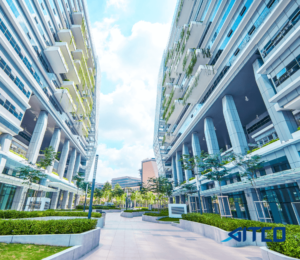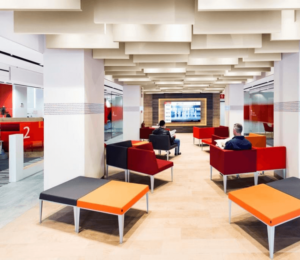In an era where sustainability and environmental compliance are no longer optional but required, industries across Saudi Arabia and the Middle East are rethinking the way they design and build spaces. One key area of transformation is acoustic design. Noise control not only impacts comfort but also productivity, well-being, and energy efficiency.
Enter green compliant acoustic products—materials specifically designed to provide superior sound absorption and noise reduction while complying with global green building standards. From LEED and WELL certifications to Saudi Arabia’s Vision 2030 sustainable development goals, these advanced solutions allow businesses and developers to integrate eco-friendly acoustics without compromise.
At GITCO, we believe in delivering innovation that meets compliance, ensuring our acoustic solutions contribute to a quieter, healthier, and more responsible built environment.
Table of Contents
What Are Green Compliant Acoustic Products?
Green compliant acoustic products are sound-control solutions manufactured using sustainable, recyclable, or low-impact materials, ensuring alignment with green construction regulations. Their compliance is usually measured against international frameworks, such as:
- LEED (Leadership in Energy and Environmental Design) – prioritizing sustainable materials and indoor environmental quality.
- WELL Building Standard – focusing on occupant health and wellbeing through reduced noise and better sound environments.
- BREEAM & Estidama – regional and global standards that highlight eco-friendly construction practices.
These products are designed not only to control reverberation, reduce external noise, and improve speech clarity, but also to minimize their environmental footprint from production to end-of-life.
Benefits of Green Compliant Acoustic Products
- Environmental Responsibility – Manufactured from recycled or renewable resources, reducing carbon footprint.
- Certification & Compliance – Supports architectural projects in achieving LEED, WELL, or local sustainability ratings.
- Healthier Indoor Spaces – Low VOC emissions, non-toxic finishes, and improved indoor air quality.
- Energy Efficiency – Enhance insulation while reducing HVAC loads.
- Design & Flexibility – Available in panels, baffles, ceiling systems, and decorative solutions without sacrificing aesthetics.
- Long-Term Cost Savings – Durable, low-maintenance, and aligned with sustainable construction goals.
Types of Green Compliant Acoustic Products
- Recycled PET Felt Panels – Made from post-consumer plastics, offering stylish, lightweight, and recyclable sound absorption.
- Wood Wool Panels – Crafted from natural, biodegradable fibers bonded with mineral binders for sustainability.
- Acoustic Fabric Panels with Eco-Cores – Fabrics sourced from low-toxicity textiles combined with recyclable acoustic cores.
- Sustainable Ceiling Baffles & Acoustic Clouds – Green-compliant alternatives to synthetic, energy-intensive panels.
- Natural Fiber Panels ( Hemp, Cotton, Jute ) – 100% renewable, biodegradable, and VOC-free materials.
Applications in Saudi Arabia & the GCC
Green building compliance is a central pillar of Vision 2030, and eco-acoustic solutions are increasingly applied across sectors in the Kingdom of Saudi Arabia and neighboring GCC countries:
- Corporate & Government Offices – Enhancing acoustics while maintaining sustainable development standards.
- Healthcare & Hospitals – Providing patient comfort with safe, compliant, and low-emission materials.
- Educational Institutions – Promoting effective learning environments using green-certified sound solutions.
- Hospitality and Entertainment – Aligning guest comfort with eco-compliance requirements.
- Residential Projects & Smart Cities – Supporting sustainable modern homes designed for efficiency and wellness.
GITCO’s Role in Delivering Green Compliant Acoustics
As one of the leading solution providers in Saudi Arabia, GITCO-Saudi Arabia collaborates with global manufacturers of certified green acoustic products. Our mission is to ensure that every project—whether commercial, educational, healthcare, or residential—benefits from legally compliant, environmentally responsible, and performance-driven acoustics.
By choosing GITCO’s green acoustic solutions, you’re not just reducing noise—you’re ensuring your project actively contributes to a sustainable, Vision 2030-aligned future.
Know more about “Green Compliant Acoustic Products”:
1. The Core Concept
- What are “Green Compliant Acoustic Products”? These are soundproofing and sound-absorbing products that adhere to environmental standards. They are typically made from recycled, renewable, or low-impact materials, and their manufacturing process minimizes energy consumption and waste.
- Why is the “green” aspect important in acoustic solutions? It addresses two major forms of pollution: noise pollution and environmental pollution. Choosing green products reduces a project’s carbon footprint, conserves resources, and contributes to healthier indoor air quality by limiting harmful chemical emissions.
2. Materials and Manufacturing
- What common materials are used in these products? They are made from materials like recycled PET plastic felt, recycled cotton fibers, sustainably harvested wood, wood wool, and natural materials like hemp or cork.
- What is recycled PET felt, and how is it used? Recycled PET felt is a high-performance material made from recycled plastic bottles. It is lightweight, durable, and highly effective at absorbing sound, commonly used in panels, baffles, and ceiling systems.
- Are these products non-toxic and low-VOC? Yes, a key feature of green-compliant products is their low or zero Volatile Organic Compound (VOC) emissions. This ensures a healthier indoor environment for building occupants by avoiding harmful chemicals found in some traditional adhesives and binders.
- How do manufacturers make wood-based acoustic products green? By sourcing wood from FSC (Forest Stewardship Council) or PEFC-certified forests and using formaldehyde-free or low-VOC binders during production, manufacturers ensure the product is both high-performing and sustainable.
- What is the role of the manufacturing process in sustainability? A sustainable approach also considers the entire lifecycle of a product. This includes using energy-efficient production methods, minimizing waste, and having a plan for end-of-life recycling.
3. Certifications and Compliance
- What is the role of LEED certification for these products? The LEED (Leadership in Energy and Environmental Design) system awards points for using materials with high recycled content, low VOC emissions, and that are responsibly sourced. Green acoustic products help buildings achieve these points, contributing to overall certification.
- How do green acoustic products contribute to BREEAM certification? The BREEAM (Building Research Establishment Environmental Assessment Method) standard assesses a building’s environmental performance. Acoustic products contribute by meeting criteria for health and well-being (Hea 05), indoor air quality, and materials sourcing.
- What is a “Declare Label” and why is it important for acoustics? A Declare Label provides full transparency about a product’s ingredients, similar to a food nutrition label. It confirms that the product is free of harmful “Red List” chemicals, a requirement for many green building projects.
- Do these products come with specific certifications beyond LEED and BREEAM? Yes, look for certifications like Global GreenTag GreenRate, WELL Building Standard, and GREENGUARD Certification, all of which verify a product’s environmental and health-related attributes.
4. Performance and Practicality
- Do “green” acoustic products perform as well as traditional ones? Modern engineering has ensured that high-quality green acoustic products provide equal or superior performance in terms of sound absorption (NRC rating) and sound insulation (STC rating) compared to their traditional counterparts.
- Are they more expensive than non-green alternatives? While some specialized green products may have a higher initial cost, their prices are becoming more competitive. The long-term savings in energy efficiency and the value added by certifications often make them a cost-effective choice.
- Are they easy to install? Yes, many products like acoustic panels and baffles are designed for straightforward installation using mechanical fixings or low-VOC adhesives, often without the need for specialized tools.
- Can green acoustic products be used in any type of space? Yes, they are versatile and suitable for a wide range of applications, including commercial offices, schools, hospitals, residential homes, and industrial spaces, all while improving air quality and acoustics.
5. Sourcing and Supply
- How can a supplier’s website (like Gitco-sa.com) help in this search? A specialized supplier’s blog or product page is a trusted source of information. It can provide detailed technical specifications, case studies, and a direct link to a local distributor, ensuring you find products that meet both your performance and sustainability criteria.
- What is a “circular economy” in relation to these products? A circular economy model focuses on reducing waste by using materials that can be reused, recycled, or biodegraded. Green acoustic products, especially those made from recycled plastics or textiles, are a perfect example of this.
- Can I recycle these products at the end of their life? Many green acoustic products, particularly those made from recycled plastics or natural fibers, are designed to be fully recyclable at the end of their service life, preventing them from ending up in a landfill.
- What is the difference between sound absorption and sound insulation in this context? Sound absorption (e.g., panels on a wall) reduces echoes and reverberation within a room. Sound insulation (e.g., materials within a wall cavity) prevents sound from traveling through the wall. Green compliant products are available for both applications.
- Why should I choose a specialized supplier for these products? A specialized supplier like Gitco can provide expert advice, ensure the products are genuine and have the required certifications for your project (especially in a region with specific building codes like the UAE), and offer support for a complete, compliant acoustic solution.
Conclusion
The transition to green compliant acoustic products is essential for organizations striving to meet sustainability benchmarks while improving acoustic comfort. From recycled PET panels to natural fiber-based systems, GITCO provides innovative, eco-certified, and future-ready acoustic solutions across Saudi Arabia and the GCC.
Investing in environmentally responsible noise control today builds a healthier, compliant, and more sustainable tomorrow.



